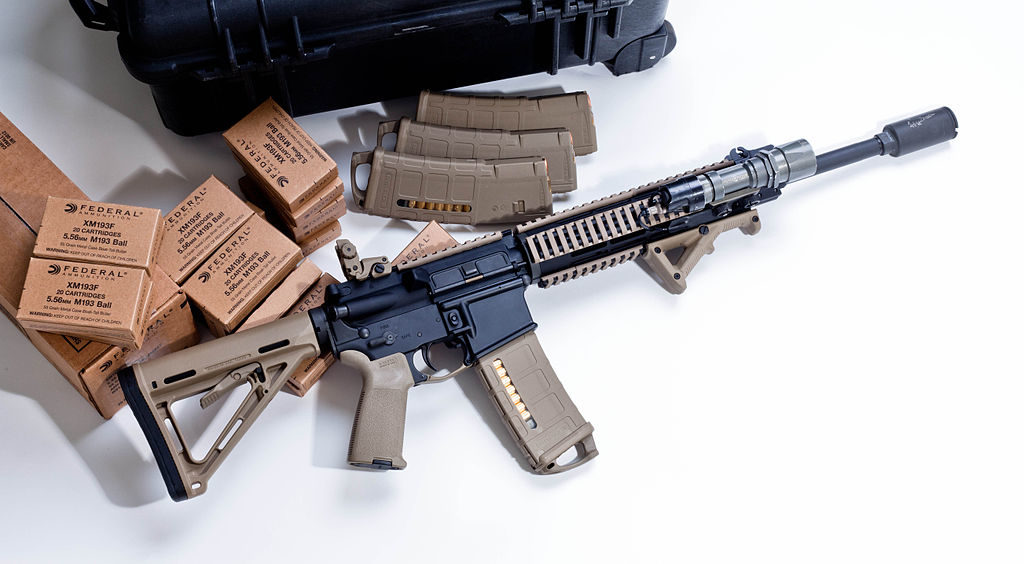About a month ago, President Donald Trump had publicly stated that he plans to pursue measures that would ban “bump stocks,” a controversial accessory that allows semi-automatic weapons to fire at a much faster rate. Bump stocks became a hot topic in October, when a gunman used the device in a deadly shooting that killed 58 people in Las Vegas. Since then, measures to ban bump stocks have been increasingly popular, but these would ultimately be pointless.
Bump stocks are accessories that use the recoil of a firearm to “bump” a semiautomatic weapon back and forth, as the shooter keeps his or her finger in place. The momentum pushes the gun forward so that the shooter’s finger pulls the trigger again, artificially creating the feel of an automatic weapon and increasing the firing rate.
At first, it may seem like banning bump stocks is a very sensible measure. But in reality, it would do very little, if anything, to reduce mass shootings. A bump stock is a very simple device, and gun users can easily replace them in any number of ways. For instance, one can get the same effect as a bump stock by using a rubber band.
A lot of people who propose measures like this do so because of a misunderstanding of how firearms work. Guns can be scary to those who are unaccustomed to them, and uninformed fear often leads to well-intentioned yet unhelpful reactions. It is important to understand firearms so that we can make informed decisions about if and how to regulate them.
Firearm Actions
A gun’s “action” refers to how the gun loads and unloads. The terms “automatic” and “semi-automatic” are types of actions. An automatic weapon fires continuously as long as the user holds the trigger. Examples of automatic weapons include the M-16 and BAR (Browning Automatic Rifle). In 1986, Congress passed the Firearm Owners’ Protection Act, which made it illegal for civilians to purchase any automatic weapons after that date.
On the other hand, semi-automatic weapons will only fire once per each pull of the trigger. The AR-15 is a famous example of a semi-automatic weapon, but most pistols are also semi-automatic.
Other types of actions include bolt-action, lever-action and pump-action. These action types fall under the blanket term “single-action.” Single-action firearms require the user to reload or otherwise prime the weapon between shots.
Within the past few weeks, House Democrats have introduced a bill to ban the sale of semi-automatic weapons in America. The man who proposed the bill, David Cicilline, said that semi-automatics are made for one purpose: “they are designed to kill as many people as possible in a short amount of time.”
“They do not belong in our communities,” Cicilline said.
Such a measure seems to make sense. Semi-automatic weapons fire at a much faster rate than single-action weapons, and therefore have the ability to do more damage.
However, the reason most people buy semi-automatic weapons is far from wholesale murder. If you are in a self-defense situation with a single-action weapon, you will likely only have one chance to fire on your attacker. If you miss, or there is more than one threat, you will likely be unable to reload fast enough to defend yourself.
A ban on semi-automatic weapons would also be highly problematic in its own right. Handguns are far and away the most common type of firearm in America. Among handguns, experts argue that semi-automatic pistols are the most useful type of guns for self-defense. When it comes to semi-automatic rifles, AR-15s are very popular in America as well, with some estimates claiming more than 5 million units in the United States. It would be very costly and time-consuming for the government to confiscate all of these weapons, especially since there is no real, effective registry of firearm owners. Therefore, it’s very likely that the government’s attempts to seize these weapons would not remove all of them. Even if the government attempted a federal buyback, studies show that buybacks rarely take dangerous weapons off the street. If an individual intended to do harm with a weapon, they’re likely not going to be willing to give it up in a buyback, even if it is mandatory.
“Assault Weapons”
When discussing issues regarding firearm rights and regulations, many make the mistake of referring to “assault weapons” or “assault rifles.” The terms are so prevalent in American rhetoric that there are currently two separate bills going through Congress that suggest ways to regulate or ban “assault weapons.”
The problem with these two terms is that pro-gun and anti-gun groups do not agree on their definition. Traditionally, the gun industry has defined an “assault rifle” as a weapon with the ability to switch between automatic and semi-automatic fire modes. As automatic weapons, “assault rifles” are effectively banned from civilian use under the Firearm Owners’ Protection Act. It is important to note that, with this definition, the AR-15 is not an assault rifle, as it is only capable of semi-automatic fire. The “AR” in AR-15 stands for “Armalite Rifle,” referring to a company that developed the weapon system; it does not stand for “assault rifle.”
“Assault weapon” is an even more problematic term. While experts argue over its origin, it does not have an agreed-upon definition in any way. This leads to issues when lawmakers try to write legislation regarding these types of weapons, because those lawmakers have to create their own definition of what an “assault weapon” is. The federal government did just that in 1994, when congress passed the Public Safety and Recreational Firearms Use Protection Act (Title XI). The federal government gave two methods to define an “assault weapon” in this act. First, it gave a list of weapons that could be considered examples of “assault weapons.” Secondly, it gave a list of features, which included things like bayonet mounts, silencers, pistol grips, and telescoping stocks. If two or more of these features were present, the weapon would be considered an “assault weapon.”
The federal assault weapons ban is highly controversial, but data suggests that it did very little to reduce gun violence. This is because of many factors, including loopholes in the law and the fact that assault weapons were not used in most shootings beforehand. In 2004, it was allowed to expire, and it is no longer law in the United States. After 2004, some states, such as California and Massachusetts, have instituted their own “assault weapons” bans, which are often based on the expired federal ban.
These previous bans are largely why pro-gun activists oppose measures to ban “assault weapons.” When writing legislation for such laws, lawmakers have to decide what is and isn’t an “assault weapon.” If a measure like the 1994 ban were to pass again, it would likely only serve to frustrate legal gun users, while not actually curbing gun violence. Therefore, it would be more productive to simply discuss what specific features should or should not be allowed on civilian firearms, and avoid using a vague term like “assault weapon.”
Silencers
Certain accessories that users can add to firearms are often the subject of scrutiny by proponents of stricter gun laws. Tools such as silencers and high-capacity magazines are hot topics when it comes to gun control. Is it reasonable to want to ban these accessories, which seem to only add to the deadliness of a weapon?
First, let’s look at so-called “silencers.” Unlike what you may see in action movies, silencers do not make gunshots so quiet that they become undetectable. In reality, firearms with silencers are still very loud. If a gun user outfitted an AR-15 with a silencer, for example, the shot would sound off at around 135 decibels. This is about as loud as a jackhammer.
The real appeal of silencers is to protect the hearing of the person using the weapon, as they usually bring the noise down to a tolerable level. The fear that silencers would allow murderers to shoot people covertly is unrealistic.
High-Capacity Magazines
Another common point of contention is high-capacity magazines. A “magazine” is a detachable device that stores ammunition, and then feeds the ammunition into the firearm. Definitions vary on what is considered a “high-capacity magazine.” Generally, it refers to magazines that hold more than 10 rounds of ammunition. Some magazines hold 30, 60 or even 100 rounds, which seems like overkill to proponents of gun control. This leads anti-gun activists too often asking, “why does anyone need a high-capacity magazine?”
I believe the issue of high-capacity magazines is one where anti-gun and pro-gun activists can find a productive middle ground. Practically, there’s no reason someone would need 50 or 100 rounds in a self-defense situation. When a magazine holds that many rounds, its only practical purpose is as a toy at the firing range. Banning magazines with such ridiculously high capacities would not be an unreasonable proposition.
That said, however, limiting civilians to magazines that only carry 10 or fewer rounds is arbitrary and dangerous. When people are nervous, as they would be in a self-defense situation, their accuracy with a weapon decreases significantly. This is even true for trained police officers. If the assailant is moving, or using cover, that accuracy will be decreased even more.
If you are in a dangerous situation, you want to be sure you won’t run out of ammunition before you can neutralize the threat. In some situations, 10 rounds may not be enough, especially if there is more than one threat.
For these reasons, civilians should have access to magazines exceeding 10 rounds. Magazines that carry 50 rounds, however, are admittedly excessive, and probably unlikely to have any practical purpose when it comes to self-defense. People discussing how to regulate magazines should strive to find a capacity limit that restricts unreasonably dangerous weaponry, while also allotting a safe buffer for civilians.
What do we do?
One of the biggest questions that Americans need to ask is how we can stop the apparent epidemic of mass shootings in our country. This is a very pressing and important issue, and it will require a lot of thoughtful and careful discussion to find a solution. Perhaps certain gun-control measures would be the proper response. Perhaps arming teachers, with plenty of precautions, would be a more effective way of protecting students.
Whatever course you think the nation should take, it’s important avoid the misunderstandings that fool many gun-control advocates. With guns, as well as with any topic, it’s important to thoroughly research what you’re talking about so that you can inform others and support measures that will lead to a real, productive change.
Featured Image Citation: Photo of an AR-15. Photo by docmonstereyes on Flickr, licensed under CC BY 2.0. No changes were made to the original image. Use of this image does not indicate photographer endorsement of this article. Image link: https://www.flickr.com/photos/72538882@N00/5572764141







Nicole White • Mar 28, 2018 at 7:29 pm
This is a great piece, Hunter! A lot of people I know are very uninformed about firearms, believing that it is a practical solution to “ban all guns”. Thank you so much for writing this, I learned a lot about guns, and now I can make smarter decisions when stating my views on this topic. 🙂
Kamen • Mar 28, 2018 at 6:14 pm
Awesome work.